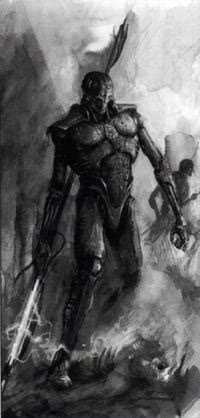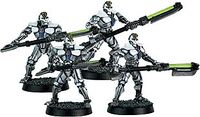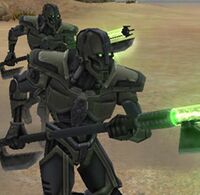Pariah: Difference between revisions
1d4chan>Jaimas mNo edit summary |
1d4chan>Unauthorised mNo edit summary |
||
| Line 9: | Line 9: | ||
Thankfully, the unit can still actually be used in Tabletop 40K, where it has become somewhat popular among Necron old-guard players to have them [[Counts As|count as]] a [[Lychguard]]. | Thankfully, the unit can still actually be used in Tabletop 40K, where it has become somewhat popular among Necron old-guard players to have them [[Counts As|count as]] a [[Lychguard]]. | ||
Despite the removal, there are still, interestingly, ample references to the unit in-universe (mostly describing it as a failed or experimental Necron model), and there is talk of bringing the unit back in later editions, though there has been no evidence of that happening just yet. Many fa/tg/uys have argued that actually implementing them in the current setting wouldn't be even that hard, given that [[Necron Lord]]s and their retainers have a great deal of influence in their armies post sixth edition, and could conceivably be trying some [[Franken Fran|science with terrible implications]]. The Pariah could even be the work of an escaped [[C'Tan]] shard or an experiment by some [[Heresy|heretical]] nutjob | Despite the removal, there are still, interestingly, ample references to the unit in-universe (mostly describing it as a failed or experimental Necron model), and there is talk of bringing the unit back in later editions, though there has been no evidence of that happening just yet. Many fa/tg/uys have argued that actually implementing them in the current setting wouldn't be even that hard, given that [[Necron Lord]]s and their retainers have a great deal of influence in their armies post sixth edition, and could conceivably be trying some [[Franken Fran|science with terrible implications]]. The Pariah could even be the work of an escaped [[C'Tan]] shard or an experiment by some [[Heresy|heretical]] nutjob Planetary Governor or well-meaning fool [[Extra Heresy|fucking around with Xeno-tech]]. | ||
==The Unit on Tabletop== | ==The Unit on Tabletop== | ||
| Line 18: | Line 18: | ||
They were riddled with downsides; they were disproportionately expensive, lacked the "We'll Be Back!" rule (because they were cyborgs, not true Necrons), and like most early edition Necrons, they lacked any ability to get them into battle faster, since the Necrons lacked dedicated transports. They didn't even have ranged attacks. | They were riddled with downsides; they were disproportionately expensive, lacked the "We'll Be Back!" rule (because they were cyborgs, not true Necrons), and like most early edition Necrons, they lacked any ability to get them into battle faster, since the Necrons lacked dedicated transports. They didn't even have ranged attacks. | ||
The reason the unit was worth fielding anyway? Because few units could quite scare the ever-loving ''hell'' out of other players like the damn things. Vehicles, infantry, daemons - if it could get tied up in close combat against a Pariah squad, odds are high it was going down. Pariahs boasted a rock-solid statblock, were the only non-HQ Necron with decent initiative, were Fearless, and their unique rules were simply amazing: Psychic Abomination made it so that ''any'' unit within 12" of them counted as having a Leadership score of 7 - the same as an [[Ork]] Boy or [[Imperial Guard|Guardsman]]. This made it much more likely that any opponent they fought would lose the morale check and be | The reason the unit was worth fielding anyway? Because few units could quite scare the ever-loving ''hell'' out of other players like the damn things. Vehicles, infantry, daemons - if it could get tied up in close combat against a Pariah squad, odds are high it was going down. Pariahs boasted a rock-solid statblock, were the only non-HQ Necron with decent initiative, were Fearless, and their unique rules were simply amazing: Psychic Abomination made it so that ''any'' unit within 12" of them counted as having a Leadership score of 7 - the same as an [[Ork]] Boy or [[Imperial Guard|Guardsman]]. This made it much more likely that any opponent they fought would lose the morale check and be subsequently vulnerable to a [[Rape|sweeping advance]]. Just as terrifying, their Warscythes allowed no saves whatsoever, which is pretty damned scary on a unit that was already hitting at Strength 5, and it added 2d6 to armor penetration against vehicles. In the early editions, Feel No Pain would not kick in if the unit was hit by an attack that ignored their armor save. | ||
Unfortunately, in spite of their power, they were not a hugely popular choice other than for lore reasons and for a [[DISTRACTION CARNIFEX|certain tactic]]. The problem with Pariahs was very simple: They cost a lot, and for a unit that was only slightly tougher to kill than a standard Necron Warrior and would [[Vindicator|fundamentally draw the fire of every high-priority unit your opponent had]], usually getting obliterated outright no later than turn 3. | Unfortunately, in spite of their power, they were not a hugely popular choice other than for lore reasons and for a [[DISTRACTION CARNIFEX|certain tactic]]. The problem with Pariahs was very simple: They cost a lot, and for a unit that was only slightly tougher to kill than a standard Necron Warrior and would [[Vindicator|fundamentally draw the fire of every high-priority unit your opponent had]], usually getting obliterated outright no later than turn 3. | ||
| Line 25: | Line 25: | ||
[[File:PariahDOW.jpg|200px|thumb|right|The bane of all that lives.]] | [[File:PariahDOW.jpg|200px|thumb|right|The bane of all that lives.]] | ||
Pariahs were one of the late-game units available to the Necrons in Dawn of War, introduced in Dark Crusade, and one of the most powerful melee units in the game, despite not having damage that's particularly impressive. Instead, they had monstrous amounts if hit-points, extremely fast | Pariahs were one of the late-game units available to the Necrons in Dawn of War, introduced in Dark Crusade, and one of the most powerful melee units in the game, despite not having damage that's particularly impressive. Instead, they had monstrous amounts if hit-points, extremely fast regeneration and reinforce times, were one of the fastest Necron units, were morale-immune, and had a nasty ability. While their damage was slightly below that of the Grey Knights (bad for a late-game unit but decent in its own right), every hit from a Pariah's warscythe permanently lowered the max HP and movement speed of the afflicted unit. While these effects ended if the Pariah that inflicted them was destroyed, Pariahs could cripple the movement speed of an enemy unit and destroy virtually any opponent, 1-on-1, in short order. Uniquely, Pariahs were also the only Necron unit other than the Necron Lord and Nightbringer to deal decent anti-Daemon damage. | ||
===Thomas Macabee=== | ===Thomas Macabee=== | ||
Revision as of 16:58, 21 December 2018
| This article or section is about something oldschool - and awesome. Make sure your rose-tinted glasses are on nice and tight, and prepare for a lovely walk down nostalgia lane. |

The Necron Pariah was an experimental Necron subtype intended to bolster the effectiveness of Necron forces against psionic races. Rather than simply be creatures of living metal, the Pariah is a horrifying symbiosis of human physiology and Necron living metal, making them into what are, effectively, half-living Necron cyborgs. They were made from Blanks - humans who possessed the unique trait of being anathema to Psykers. Lore implications, prior to 6th edition, were that Pariahs were a case of the Necrontyr seeding humanity with the "Pariah Gene" that resulted in Blanks occurring, perhaps specifically to use them against their old foes or the followers of the chaos gods... Or perhaps even the Emperor himself.
With the arrival of 6th edition, Pariahs were entirely removed from the Necron army lists, as the backstory and lore of the Necrons were entirely altered, essentially retconning, for the most part, the unit out of existence. This removal, fluff-wise, is considered by many of /tg/'s historians to be one of the most tragic lost opportunities in all of Warhammer 40,000, as many subplots tied to the Necrons were centered around this new unit. In the new canon, Humanity had not evolved yet during the time of the Necrontyr, and, as such, the Necrons never seeded humanity with the Pariah Gene.
Thankfully, the unit can still actually be used in Tabletop 40K, where it has become somewhat popular among Necron old-guard players to have them count as a Lychguard.
Despite the removal, there are still, interestingly, ample references to the unit in-universe (mostly describing it as a failed or experimental Necron model), and there is talk of bringing the unit back in later editions, though there has been no evidence of that happening just yet. Many fa/tg/uys have argued that actually implementing them in the current setting wouldn't be even that hard, given that Necron Lords and their retainers have a great deal of influence in their armies post sixth edition, and could conceivably be trying some science with terrible implications. The Pariah could even be the work of an escaped C'Tan shard or an experiment by some heretical nutjob Planetary Governor or well-meaning fool fucking around with Xeno-tech.
The Unit on Tabletop

In early editions, on the tabletop, Pariahs were the kingmaker among units that were ineffective for cost, but still effective enough to be worth taking.
They were riddled with downsides; they were disproportionately expensive, lacked the "We'll Be Back!" rule (because they were cyborgs, not true Necrons), and like most early edition Necrons, they lacked any ability to get them into battle faster, since the Necrons lacked dedicated transports. They didn't even have ranged attacks.
The reason the unit was worth fielding anyway? Because few units could quite scare the ever-loving hell out of other players like the damn things. Vehicles, infantry, daemons - if it could get tied up in close combat against a Pariah squad, odds are high it was going down. Pariahs boasted a rock-solid statblock, were the only non-HQ Necron with decent initiative, were Fearless, and their unique rules were simply amazing: Psychic Abomination made it so that any unit within 12" of them counted as having a Leadership score of 7 - the same as an Ork Boy or Guardsman. This made it much more likely that any opponent they fought would lose the morale check and be subsequently vulnerable to a sweeping advance. Just as terrifying, their Warscythes allowed no saves whatsoever, which is pretty damned scary on a unit that was already hitting at Strength 5, and it added 2d6 to armor penetration against vehicles. In the early editions, Feel No Pain would not kick in if the unit was hit by an attack that ignored their armor save.
Unfortunately, in spite of their power, they were not a hugely popular choice other than for lore reasons and for a certain tactic. The problem with Pariahs was very simple: They cost a lot, and for a unit that was only slightly tougher to kill than a standard Necron Warrior and would fundamentally draw the fire of every high-priority unit your opponent had, usually getting obliterated outright no later than turn 3.
The Unit in Dawn of War

Pariahs were one of the late-game units available to the Necrons in Dawn of War, introduced in Dark Crusade, and one of the most powerful melee units in the game, despite not having damage that's particularly impressive. Instead, they had monstrous amounts if hit-points, extremely fast regeneration and reinforce times, were one of the fastest Necron units, were morale-immune, and had a nasty ability. While their damage was slightly below that of the Grey Knights (bad for a late-game unit but decent in its own right), every hit from a Pariah's warscythe permanently lowered the max HP and movement speed of the afflicted unit. While these effects ended if the Pariah that inflicted them was destroyed, Pariahs could cripple the movement speed of an enemy unit and destroy virtually any opponent, 1-on-1, in short order. Uniquely, Pariahs were also the only Necron unit other than the Necron Lord and Nightbringer to deal decent anti-Daemon damage.
Thomas Macabee
Thomas Macabee was a character that acted as the "voice" of the Necron Lord of Kronus, essentially acting as the army's herald because none of the Necrons of this edition, Grandpa Lord aside, would communicate with anything more than beeps, clicks, and clanks. Originally, Macabee was an ordinary human, as well as an Archaeology professor that served the Tau as part of a Gue'vesa auxillary unit on Kronus. Macabee and his team unwittingly awoke the Necrons, breaking the stasis on their tomb complex, and while his entire team was slaughtered, Macabee was captured instead, as he was a Pariah Gene carrier. While not especially creative or witty compared to the other commanders, there is a certain amusement to a faction whose sole speaking member simply assures the enemy that they are, indeed, fucked, and going to die.